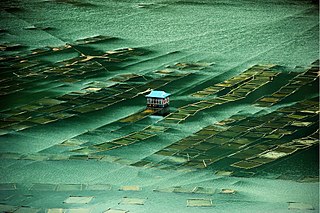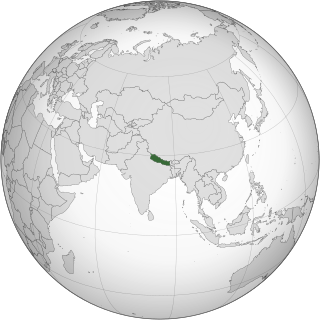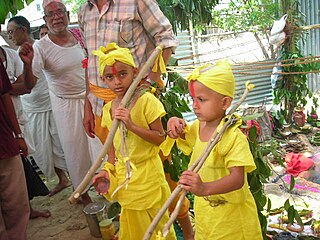Related Research Articles

Dalit is a term first coined by the Indian social reformer Jyotirao Phule for untouchables and outcasts, who represented the lowest stratum of the castes in the Indian subcontinent. Dalits were excluded from the fourfold varna of the caste hierarchy and were seen as forming a fifth varna, also known by the name of Panchama. Several scholars have drawn parallels between Dalits and the Burakumin of Japan, the Baekjeong of Korea and the peasant class of the medieval European feudal system.

Hinduism is the main and largest religion of Nepal. In 2006, the country declared itself a secular country through democracy, after the abolition of its monarchy. According to the 2021 census, the Hindu population in Nepal is estimated to be around 23,677,744 which accounts for at least 81.19% of the country's population, the highest percentage of Hindus of any country in the world. Vikram Samvat, one of the two official calendars used in Nepal, is a solar Hindu calendar essentially the same to that widespread in North India as a religious calendar, and is based on Hindu units of time.

Khas tribe, popularly known as Khashya, according to the 2015 constitution of Nepal are an Indo-Aryan ethno-linguistic group native to the Himalayan region of the Indian subcontinent, in what is now the South Asian country of Nepal, as well as the Indian states of Uttarakhand, Himachal Pradesh, West Bengal, Assam and Sikkim.

Chhetri, historically called Kshettriya or Kshetriya or Khas are a Nepali speaking warrior group of Khas community, some of whom trace their origin to migration from medieval India. Chhetri was a caste of administrators, governors,warriors and military elites in the medieval Khas Kingdom and Gorkha Kingdom. The nobility of the Gorkha Kingdom mainly originated from Chhetri families. They also had a strong presence in civil administration affairs. The bulk of prime ministers of Nepal before the democratization of Nepal belonged to this caste as a result of the old Gorkhali aristocracy. Gorkha-based aristocratic Chhetri families included the Pande dynasty, the Basnyat dynasty, the Kunwar family, and the Thapa dynasty,.

Makwanpur District, in Bagmati Province, earlier a part of Narayani Zone, is one of the seventy-seven districts of Nepal. The city of Hetauda serves as the district headquarters and also as the provincial headquarters. The district covers an area of 2,426 km2 (937 sq mi) and had a population of 392,604 in 2001 and 420,477 in 2011. The latest census of 2021 recorded the population of Makwanpur as 466,073.

Chamar is a Dalit community classified as a Scheduled Caste under modern India's system of affirmative action. They are found throughout the Indian subcontinent, mainly in the northern states of India and in Pakistan and Nepal.
Chuhra, also known as Bhanghi and Balmiki, is a Dalit caste in India and Pakistan. Populated regions include the Punjab region of India and Pakistan, as well as Uttar Pradesh in India, among other parts of the Indian subcontinent such as southern India. Their traditional occupation is sweeping, a "polluting" occupation that caused them to be considered untouchables in the caste system.
The Nepalese caste system was the traditional system of social stratification of Nepal. The Nepalese caste system broadly borrows the classical Hindu Chaturvarnashram model, consisting of four broad social classes or varna: Brahmin, Kshatriya, Vaishya, Sudra.

Chitrakar is a caste within the Newar community of the Kathmandu Valley in Nepal. The Newar caste system is divided according to profession. Accordingly, Chitrakars were painters and mask makers.
The caste system among South Asian Christians often reflects stratification by sect, location, and the caste of their predecessors. There exists evidence to show that Christian individuals have mobility within their respective castes. But, in some cases, social inertia caused by their old traditions and biases against other castes remain, causing caste system to persist among South Asian Christians, to some extent. Christian priests, nuns, Dalits and similar groups are found in India, Pakistan, Bangladesh, and Nepal.

Lesbian, gay, bisexual, and transgender (LGBT) rights in Nepal have expanded in the 21st century, though much of Nepal's advancements on LGBT rights have come from the judiciary and not the legislature. Same-sex sexual acts have been legal in Nepal since 2007 after a ruling by the Supreme Court of Nepal.
Persecution and discrimination against Dalits has been observed in the countries such as Bangladesh, India, Pakistan, Nepal, the UK, and the US.
Nepalese Muslims are Nepalis who follow Islam. Their ancestors arrived in Nepal from different parts of South Asia, Central Asia and Tibet during different epochs, and have since lived amidst the numerically dominant Hindus and Buddhists. About 80% of the Muslim community live in the Terai region, while the other 20% are found mainly in the city of Kathmandu and Gorkha and the western hills. The community numbers 1,483,060, about 5.09% of the total population of Nepal. Districts with large Muslim population include Sarlahi (9.9%), Rautahat (17.2%), Bara (11.9%), and Parsa (17.3%) and Banke (16%) in the western Terai and Siraha (7%) and Sunsari (10%) and Saptari (10%) hill.

Tripurasundari, also known as Lalit Tripura Sundari Devi, was a queen consort of Nepal by marriage to King Rana Bahadur Shah of Nepal. Widowed at a very young age and childless, she served as regent of the kingdom for a long period. She was regent for her stepson Girvan Yuddha Bikram Shah in 1806–1819, and for her step-grandson Rajendra in 1819–1832. She was the first woman to publish literature in Nepal.

Eastern Rukum is a mountain district of Lumbini Province of Nepal situated along the Dhaulagiri mountain range. It is also the only mountain district of the province with its tallest mountain Putha Hiunchuli situated in the west end of Dhaulagiri II mountain chain, at an elevation of 7,246 meters. The drainage source of ancient Airavati river, one of the five sacred rivers of Buddhism, lies in the lesser Himalayas of the district. With a Dhaulagiri mountain range, lakes, Magar culture and its political history, Eastern Rukum has been among the top travel destinations of Nepal as designated by the Government of Nepal.

Dalit feminism is a feminist perspective that includes questioning caste and gender roles among the Dalit population and within feminism and the larger women's movement. Dalit women primarily live in South Asia, mainly in Bangladesh, India, Nepal and Pakistan. Dalit women face different challenges than women in oppressor castes in these countries. They are more likely to be poor, uneducated and socially marginalized. Dalit feminists advocate and have advocated for equal rights for Dalit women based on gender, caste and other issues. They have addressed conferences, created organizations and helped elect other Dalit women into political office.

Tagadhari are members of a Nepalese Hindu group that is perceived as historically having a high socio-religious status in society. Tagadhari are identified by a sacred thread (Janai) around the torso, which is used for ritualistic purposes in Hinduism. In Sanskrit the sacred thread is called yajñopavītam and in Nepali Janai. The cord is received after the Upanayana ceremony. Tagadharis were historically favoured by the government of Nepal and various religious and caste-based legal provisions were enacted on their behalf. The legal code of 1854, Muluki Ain, which was introduced by Chhetri Maharaja and Prime Minister of Nepal Narsingh Jang Bahadur Kunwar Ranaji, made it impossible to legally enslave Tagadharis and decreed fewer punishments for them in comparison to Matawali and Dalits.

Inter-caste marriage is a type of marriage that is done outside of one's caste. Nepal has many castes and inter-caste marriage is generally considered taboo. However, this kind of marriage has been gradually gaining acceptance.
KC is a surname of medieval Indian origin anglicized as an abbreviation of Khatri Chhetri in Nepal. The surname Khatri Chhetri was historically legally labelled to the children of Brahmin fathers and Kshatriya (Chhetri) mothers after the introduction of Muluki Ain in 1854 by Jang Bahadur Rana of Nepal. With its origin in the 12th century CE, the archaic form of the surname "Khatri" was ascribed as a local endonym for the progeny of Brahmins from Medieval India and Khas women of the Middle Himalayas in medieval western Nepal.

Yash Kumar is a Nepali singer, songwriter, music composer, and actor. He has received numerous awards, including, Best playback singer,3rd Himalayan international Nepali Music Award(Dubai)2020. 4th Epic Nepal Music Award 2079,Best modern singer. AMIN National Music Award 2023, Best Decade Singer. Nepal Music and fashion AWARD 2022. Best Singer. 2nd Silver international Music AWARD 2023(Malaysia) Best Debut actor (NEFTA)2011 from National Film Award. He is also an activist against the untouchability system in Nepal. He has been Honoured by President Ram chandra Poudel with Social service Award on the occasion of constitutional day
References
- ↑ Trigunayat, Samarth (21 August 2014). "Inter-caste & Inter-Religious Marriages: Social And Legal Issues". www.lawctopus.com. Retrieved 2021-07-21.
- ↑ "Why is Inter-Caste Marriage a Problem?". DESIblitz. 2015-12-26. Retrieved 2021-07-21.
- ↑ Tish Sanghera (22 October 2020). "Inter-caste marriages depend on education level, but not that of the couple". Business Standard. Retrieved 19 October 2020.
- 1 2 3 4 Basnet, Chudamani; Jha, Ratnakar (29 October 2019). "Crossing the Caste and Ethnic Boundaries: Love and Intermarriage Between Madhesi Men and Pahadi Women in Southern Nepal". South Asia Multidisciplinary Academic Journal (in French). doi: 10.4000/samaj.5802 . ISSN 1960-6060. Archived from the original on 24 June 2020. Retrieved 24 June 2020.
- ↑ "Nepali Politics And The Rise of Jang Bahudur Rana, 1830–1857" (PDF). ProQuest. Retrieved 25 June 2020.
- ↑ "Abrogation of Some Criminal Cases and Remission of Punishment Act, 2020 (1963)". Nepal Law Commission. Retrieved 2020-06-25.
- ↑ Bishwakarma, Mom (7 March 2019). Political Transformations in Nepal: Dalit Inequality and Social Justice. Routledge. ISBN 978-0-429-75615-3. Archived from the original on 24 June 2020. Retrieved 24 June 2020.
- ↑ Yadav, Punam (28 April 2016). Social Transformation in Post-conflict Nepal: A Gender Perspective. Routledge. ISBN 978-1-317-35390-4. Archived from the original on 24 June 2020. Retrieved 24 June 2020.
- ↑ "Nepal, an emerging rainbow nation". Nepali Times. Archived from the original on 11 March 2018. Retrieved 24 June 2020.
- ↑ "Inter-caste Newlyweds Face Eviction, Discrimination in Nepal". Global Press Journal. 10 August 2010. Archived from the original on 24 June 2020. Retrieved 24 June 2020.
- 1 2 3 Sunar, Giri Bahadur. "Rough road to inter-caste marriage". My Republica. Retrieved 24 June 2020.
- ↑ "Pakistan: Domestic violence in intercaste marriages; state protection and support services for victims". Immigration and Refugee Board of Canada. 2019. Archived from the original on 2021-07-21. Retrieved 2021-07-21.
- ↑ "The Views of British Asians on Inter-Caste marriage". DESIblitz. 2020-06-28. Retrieved 2021-07-21.
- ↑ Ashis Ray (Aug 19, 2011). "Intercaste marriage costs UK couple job - Times of India". The Times of India. Retrieved 2021-07-21.
- ↑ Qureshi, Javed Ahmed (11 April 2020). "Marriage in Islam" (PDF). Jiwaji University.
- ↑ Quran 2:221 (Translated by Yusuf Ali)
- ↑ Singh, Gurbachan; Shankar, Sondeep (1998). The Sikhs: Faith, Philosophy & Folk. Lustre Press. p. 26. ISBN 9788174360373.